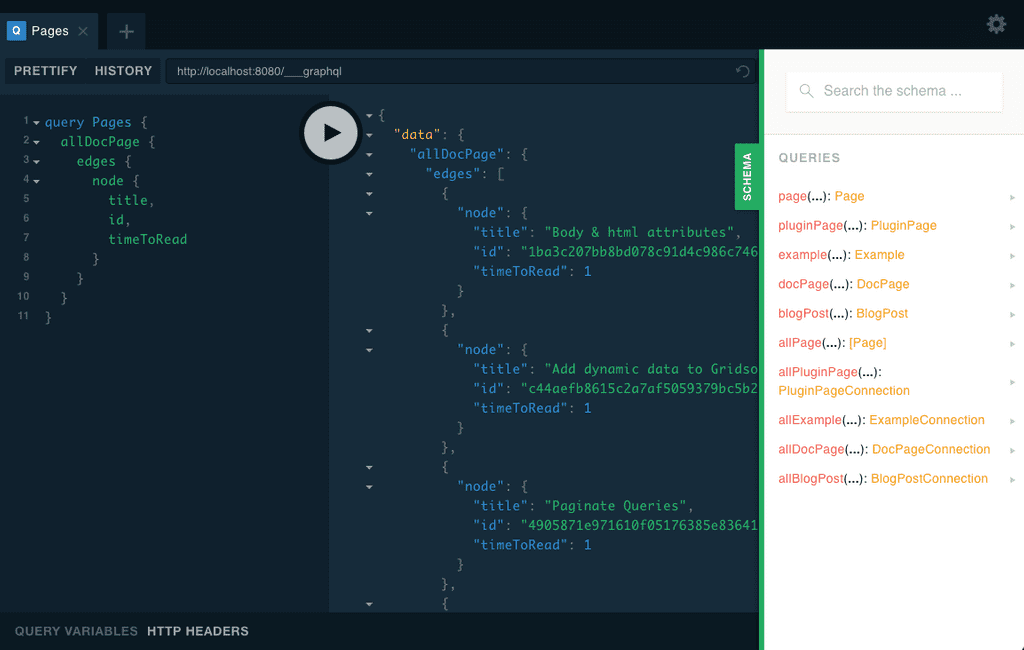Querying data
You can query fetched data into any Page, Template or Component. Queries are added with a <page-query> or <static-query> block in Vue Components.
- Use
<page-query>in Pages & Templates. - Use
<static-query>in Components.
How to query with GraphQL
Working with GraphQL in Gridsome is easy and you don't need to know much about GraphQL. Here is an example of how to use GraphQL in page-query for a page:
<template> <div> <div v-for="edge in $page.posts.edges" :key="edge.node.id"> <h2>{{ edge.node.title }}</h2> </div> </div> </template> <page-query> query Posts { posts: allWordPressPost { edges { node { id title } } } } </page-query>
With GraphQL you only query the data you need. This makes it easier and more tidy to work with data. A query always starts with query and then something like Posts (Can be anything). Then you write something like posts: allWordPressPost. The allWordPressPost is the name of the GraphQL collection you want to query. The posts: part is an optional alias. When using posts as alias, your data will be available at $page.posts (or $static.posts if you use <static-query>). Otherwise it will be available at $page.allWordPressPost.
Learn more about GraphQL queries
Querying collections
Every content type has a collection and a single entry in the GraphQL schema. You will notice that some of the root fields in your schema are prefixed with all. They are the collections for each of your content types and you can use them in your pages to create lists of single entries.
| Argument | Default | Description |
|---|---|---|
| sortBy | "date" |
Sort by a node field. |
| order | DESC |
Sort order (DESC or ASC). |
| sort | Sort by multiple node fields. | |
| skip | 0 |
How many nodes to skip. |
| limit | How many nodes to get. | |
| page | Which page to get. | |
| perPage | How many nodes to show per page. Omitted if no page argument is provided. |
|
| filter | {} |
Read more. |
Find nodes sorted by title
query Posts { allPost(sortBy: "title", order: DESC) { edges { node { title } } } }
Sort a collection by multiple fields
query Posts { allPost(sort: [{ by: "featured" }, { by: "date" }]) { edges { node { title } } } }
Querying single nodes
The other fields that do not start with all are your single entries. They are typically used by templates to get data for the current page. You must provide either an id or a path as an argument to find the node.
Arguments
| Argument | Default | Description |
|---|---|---|
| id | null |
Get node by id. |
Example query
query Post { post(id: "1") { title } }
Explore & test queries
Every Gridsome project has a GraphQL explorer (Playground) that can be used to explore and test queries when in development mode. Here you also get a list of all available GraphQL collections. This can usually be opened by going to http://localhost:8080/___explore.

Query data in Pages
Every page can have a <page-query> block with a GraphQL query
to fetch data from data sources. The results will be stored in a
$page property inside the page component.
<template> <Layout> <h2>Latest blog posts</h2> <ul> <li v-for="edge in $page.posts.edges" :key="edge.node.id"> {{ edge.node.title }} </li> </ul> </Layout> </template> <page-query> query Blog { posts: allWordPressPost { edges { node { id title } } } } </page-query>
Query data in Templates
Templates are used for page layout for the single endpoint of a data source like for example a WordPress blog post. If you have a node type called WordPressPost, then you can create a file
in src/templates/WordPressPost.vue.
The page-query in templates also has a set of variables that can be used in the query. Any custom fields from the current node are available as variables. Access field values in deep objects or arrays by separating properties or indexes with double underscores (__).
$idresolves tonode.id$valueresolves tonode.fields.value$object__valueresolves tonode.fields.object.value$array__3__idresolves tonode.fields.array[3].id
<template> <Layout :title="$page.post.title"> <div v-html="$page.post.content"/> <ul> <li v-for="edge in $page.related" :key="edge.node.id"> <g-link :to="edge.node.path"> {{ edge.node.title }} </g-link> </li> </ul> </Layout> </template> <page-query> query Post($id: String!, $group: String!) { post(id: $id) { title content } related: allPost(filter: { group: { eq: $group }}) { edges { node { id title path } } } } </page-query>
Query data in Components
Every Component can have a <static-query> block with a GraphQL query to fetch data from data sources. The results will be stored in a $static property inside the component. A <static-query> is named static as it can not accept any variables.
<template> <div v-html="$static.post.content" /> </template> <static-query> query Post { post(id: "1") { content } } </static-query>